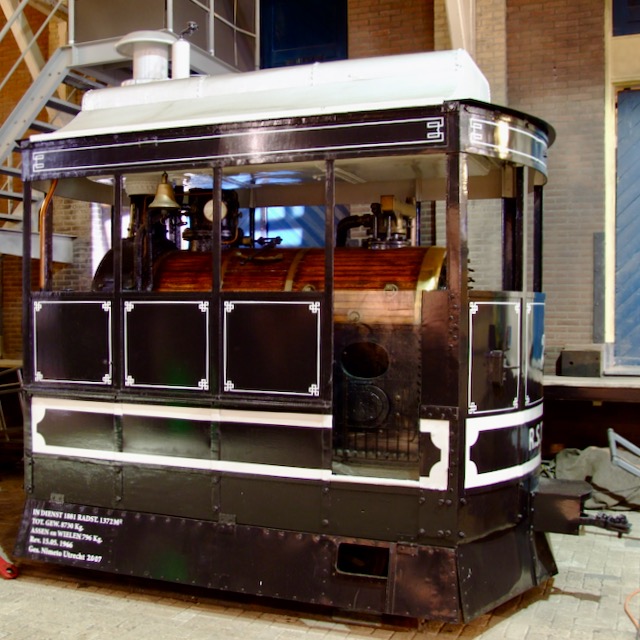
Actually the title of this page is wrong. The major activity of the Merryweather company was always making fire fight equipment. As such it was founded in 1692, although originally with a different name. Over the next 144 years the name changed several times with new owners and associates joining or leaving the firm. Fire fight equipment and its history is very interesting, but this page is about the second product that made Merryweather famous: steam tram locomotives.
In 1836 Moses Merryweather took over the company he joined 29 years before as an apprentice. Later also his sons joined and the company became Merryweather & Sons. Moses died in 1872. In 1873 Merryweather made the machinery of a by John Grantham designed steam tramcar. The car went for several years on trials on different locations and moved in 1875 to the Wantage Tramway. This was the first tramline in the UK using steam traction. It triggered Merryweather to start building steam tram locomotives. In April 1875 Merryweather patented their own locomotive design. Merryweather wasn’t the first building steam tram locomotives, at the other side of the Atlantic Ocean they were already introduced before 1870, but the company was a pioneer in Europe.
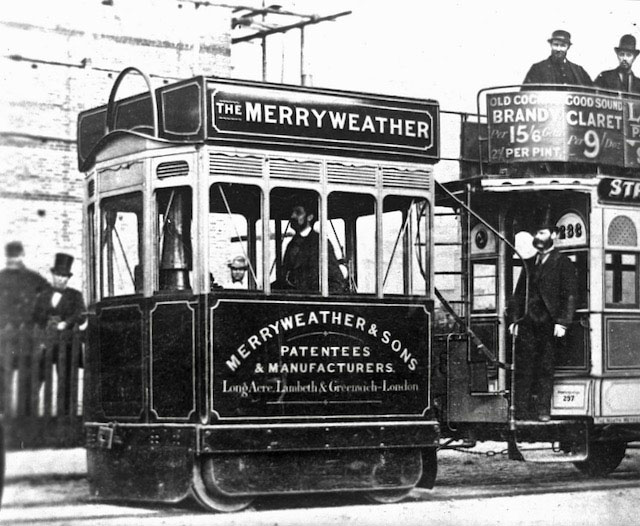
Kinnear Clark1 said that Merryweather produced three sizes of locomotives:
- Type 1: cyl-ø 6″ (152 mm); stroke 9″ (229 mm); weight in working condition about 31/2 tmetric
- Type 2: cyl-ø 7″ (178 mm); stroke 11″ (279 mm); weight in working condition about 51/2 tmetric
- Type 3: cyl-ø 71/2” (191 mm); stroke 12″ (305 mm); weight in working condition about 7 tmetric
With all types the wheel diameter was 2′ (610 mm). However Whitcombe2 said the engines were not standardised ranging the cylinder diameter from 6″ to 71/2” (152 to 191 mm) with stroke from 9″ to 12″ (229 to 305 mm) but a few had 81/2” (216 mm) or 10″ (254 mm) diameter with 14″ (356 mm) stroke. Wheels between 2′ (610 mm) and 2’4″ (712 mm) diameter, axle distance 4’6″ to 5′ (138 to 152 cm), horizontal boiler about 4′ (122 cm) long and 2’4″ (71 cm) diameter, firebox about 2’4″ (71 cm) in length, 64 to 85 brass flue tubes of 13/4” (44 mm) in diameter, average overall length 12′ (366 cm), width 6’4″ (193 cm), roof height over rails 8’6″ (295 cm), weight 6 to 71/2 tmetric.
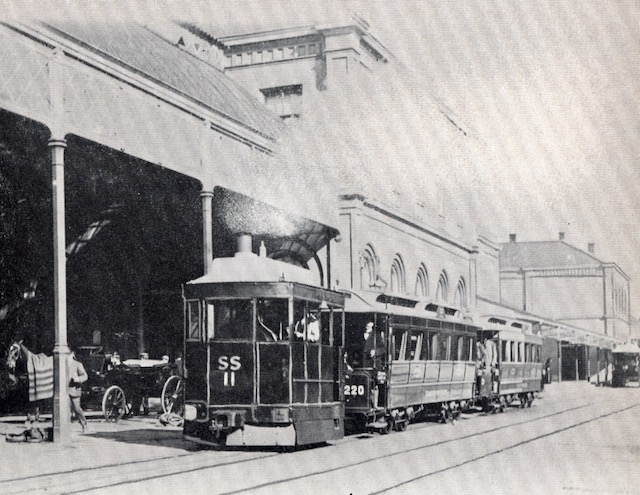
Mr. G.P. Harding ordered on behalf of the Tramways du Sud in Paris in several batches a total of 46 locomotives from Merryweather. In France the Merryweather locomotives were called “Locomotives Harding”. The first went on service in November 1875. Their success in Paris was moderate and the “Sud” ended the use of steam locomotives already in 1878. Nevertheless the potential of steam trams was proven and the use of steam locomotives on tramways boomed. Also Merryweather profited from this for several years. But by the mid 1880’s Merryweather couldn’t keep pace anymore with the many competitors. The last two locomotives were built in 1892 for a railway company in Holland, not because that company considered the type better as those of the competitors, but because it had already 17 of the type and didn’t want two locomotives that differed too much. Merryweather returned to their core business: fire fight equipment. The history of the company during the last decades of the 20th century is somewhat obscure. But as of today there still exists a company with the name Merryweather & Sons with as business fire fight equipment. The tram locomotives were only a two decade side activity during its over three centuries of existence.
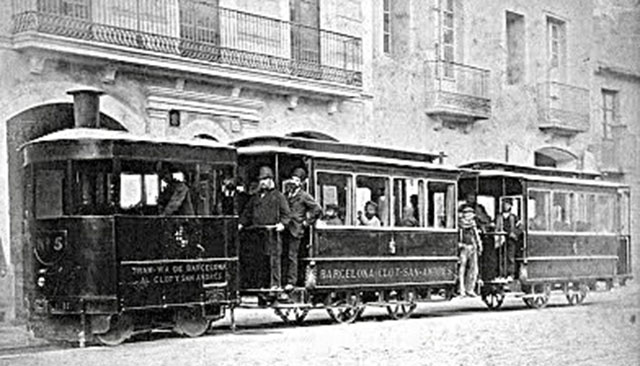
Works list
I have never found a complete works list of the Merryweather steam locomotives. Below is a reconstructed one. It contains gaps and errors. So additions and corrections are welcome.
| Works | year | qty | gauge | type | company / location |
| 1 | 1873 | 1 | 1435 | Wantage Tramway Co. no.1 Grantham Steamcar | |
| 2 | 1874 | 1 | 1435 | 1 | Wiener Tramway Gesellschaft (experimental July 1876) |
| 3-8 | 1874/6 | 6 | 1435 | 1 | Tramways de Paris – Réseau Sud nos.1-6 |
| 9 | 1876 | 1 | unknown, Wantage Tramway Co. no.2? | ||
| 10-31 | 1876 | 22 | 1435 | 1 | Tramways de Paris – Réseau Sud nos.7-28 |
| 32 | 1877 | 1 | 1435 | 1 | Wharncliffe National Rifle Association, Wimbledon |
| 33-37 | 1877 | 5 | 1435 | 3 | Cassel Tramways Co.Ltd. (London) nos.1-5 |
| 38-45 | 1876 | 8 | 1435 | 1 | Tramways de Paris – Réseau Sud nos.29-36 |
| 46-50 | 1877 | 5 | 1000 | 1 | Tranvias de Barcelona a San Andrés nos.1-5 |
| 51-60 | 1877 | 10 | 1435 | 2 | Tramways de Paris – Réseau Sud nos.37-46 |
| 60-64 | 1877 | 5 | 1067 | 2 | Wellington City Tramways Company nos.1-5 |
| 65-68 | 1877 | 4 | unknown | ||
| 69-73 | 1878 | 5 | 1000 | 2 | Tranvias de Barcelona a San Andrés nos.6-10 |
| 74 | 1878 | 1 | 1435 | Novi Ligure no.1 | |
| 75-80 | 1878 | 6 | unknown | ||
| 81 | 1878 | 1 | 1435 | 3 | Cassel Tramways Co.Ltd. (London) no.6 |
| 82 | 1878 | 1 | 1435 | 2 | Nederlandsche Rhijn Spoorweg mij. no.1 |
| 83 | 1878 | 1 | unknown | ||
| 84-85 | 1878 | 2 | 1435 | 2 | Guernsey Steam Tramway |
| 85-87 | 1878 | 3 | 1067 | 2 | Wellington City Tramways Company nos.6, 8 & 7 |
| 88-93 | 1879 | 6 | 1435 | 2 | Nederlandsche Rhijn Spoorweg mij. nos.2-7 |
| 94 | 1880 | 1 | unknown | ||
| 95 | 1880 | 1 | 1435 | 2 | Companhia Carris de Ferro do Porto no.7 |
| 96-100 | 1880 | 5 | 1435 | 2 | Nederlandsche Rhijn Spoorweg mij. nos.8-12 |
| 101-108 | 1880 | 8 | unknown | ||
| 109-112 | 1881 | 4 | 1435 | 2 | Rhijnlandsche Stoomtramweg Maatschappij nos.1-4 |
| 113-114 | 1881 | 2 | unknown | ||
| 115-119 | 1881 | 5 | 1435 | 2 | Nederlandsche Rhijn Spoorweg mij. nos.13-17 |
| 120-130 | 1881 | 11 | unknown | ||
| 131 | 1882 | 1 | 1435 | 2 | Rhijnlandsche Stoomtramweg Maatschappij no.5 |
| 132-133 | 1882 | 2 | unknown | ||
| 134-137 | 1882 | 4 | 1000 | Tranvias de Barcelona a San Andrés nos.11-14 | |
| 138-172 | 35 | unknown | |||
| 173-174 | 1892 | 2 | 1435 | 2 | Staatsspoorwegen nos.18-19 |
| 9? | 1876 | 1 | 1435 | Wantage Tramway Co. no.2 | |
| ? | 1880 | 1 | 1435 | NSWGT (Sydney) no.55, arrived April 1881. | |
| ? | 1880/1 | 9 | 1435 | 2 | Dewsbury, Batley and Birstall Tramway nos.1-9 |
| ? | 1881 | 6 | 1219 | 3 | Stockton and Darlington Steam Tramways Company |
| ? | 1881/2 | 4 | 1219 | 3 | North Staffordshire Tramways nos.3-4 & 10-11 |
| ? | 1882 | 1 | 1435 | Glenelg Railway Company (Adelaide) | |
| ? | 1882 | 1 | 1000 | Tranvias de Barcelona a San Andrés no.15 | |
| ? | 1883 | 15 | 1435 | Rangoon Steam Tramway Company | |
| ? | 1884 | 1 | 760 | Alford & Sutton Tramway no.2 | |
| ? | 1884/5 | 15 | 1435 | 3 | North London Tramways nos.1-15, |
| ? | 1889 | 2 | 1435 | Companhia Carris de Ferro de Lisboa | |
| ? | ? | ? | ? | Buenos Aires | |
| ? | ? | ? | ? | Brazil Dom Pedro Tramway |
Tramways de Paris – Réseau Sud operated steam trams from November 1875 until February 1878. Laederich3 says these “petites locomotives d’origine anglaise” were not only used in Paris, but also in Rouen from December 1877 until 1896, and Béziers from July 1879 until September 1882. Baddeley4 says that the locomotives Sud nos.34-38 & 42 and four others went to Rouen. No details are known about the locomotives of Béziers. Baddeley says the Béziers locomotives were built by Corpet, but that contradicts their english origins.
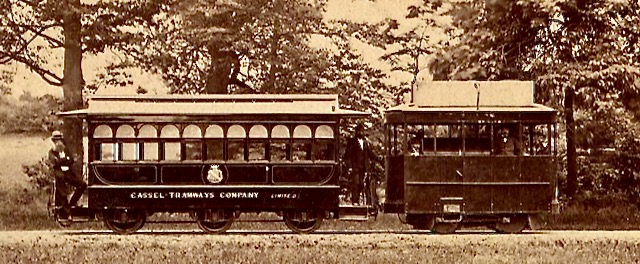
The Cassel Tramways Co.Ltd owned by Jay & Comp. in London started steam tram operations with two Merryweather locomotives on 9 July 1877. It was the first tram company in Germany using steam trams. Except for some more Merryweathers, soon also locomotives from the local firm Henschel & Sohn were acquired. The Kassel steam trams were replaced by electric trams on 10 May 1897.
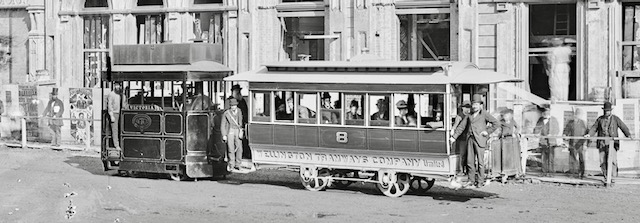
The Wellington City Tramways opened with the use of steam trams on 24 August 1878. The locomotives had the names: Florence, Hibernia, Wellington, Zealandia, Victoria, Cambria, Scotia and Anglia. Their success was limited and the system gradually converted to horse trams from January 1882. The last steam tram ran in 1892.
The Nederlandsche Rhijn Spoorweg Maatschappij. (NRS) was dissolved in 1890. The exploitation of it’s lines and the major part of the rolling stock, included all of the Merryweather locomotives, went to the Maatschappij tot Exploitatie van Staatsspoorwegen, commonly known as Staatsspoorwegen (SS).
Sources – books
Baddeley: “The Continental Steam Tram” by Geoffrey E. Baddeley, published by the LRTA (Light Rail Transit Association) 2nd edition 1982. ISBN 0900433787.
Remark 4: locomotives to Rouen pages 33 and 67.
Kinnear Clark: “Tramways, their construction and working” by D. Kinnear Clark, 2nd edition published 1894, republished by Adam Gordon in 1992. ISBN 1874422044.
Remark 1: locomotive types page 438
Laederich: “Les Tramways de chez nous” by Pierre Laederich, published by E.T.A.I. in 1998. ISBN 20003130557.
Remark 3: english locomotives page 15; use in Béziers page 103.
Overbosch: “De Stoomlocomotieven der Nederlandse Tramwegen” by S. Overbosch, 3rd edition published 1985 by De Bataafsche Leeuw. ISBN 9067070513.
Reed: “London Tramways” by John Reed, published 1997 by Capital Transport. ISBN 1854141791.
Robert: “Les Tramways Parisiens” by Jean Robert. 2nd edition published 1959.
Slezak: “Straßenbahn in Wien” by Walter Krobot (Typenskizzen), Josef Otto Slezak (Text) and Hans Sternhart (Listen Betriebs-, Strecken- Fahrparkgeschichte) 2nd edition published 1983 by Josef Otto Slezak. ISBN 3834160763.
Turner: “The Directory of British Tramways” by Keith Turner, published by Patrick Stephens Limited in 1996. ISBN 1852605499.
Whitcombe: “History of the Steam Tram” by H.A. Whitcombe, original published in 1937 and republished by Adam Gordon in 2000. ISBN 1874422281.
Remark 2: locomotive types page 346
Sources – internet
Guernsey Steam Tramway (Wikipedia)
Wantage Tramway (Wikipedia)

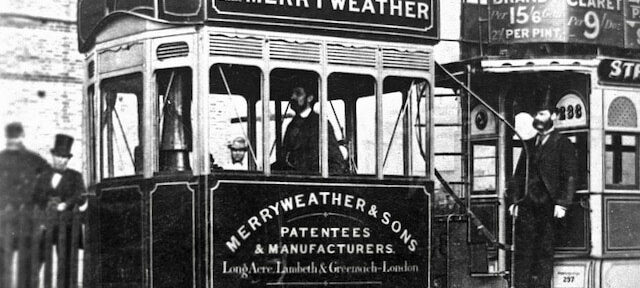
Leave a Reply